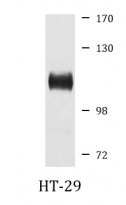ARG58476
anti-DDX11 antibody
anti-DDX11 antibody for Western blot and Human
Overview
| Product Description | Rabbit Polyclonal antibody recognizes DDX11 |
|---|---|
| Tested Reactivity | Hu |
| Tested Application | WB |
| Host | Rabbit |
| Clonality | Polyclonal |
| Isotype | IgG |
| Target Name | DDX11 |
| Antigen Species | Human |
| Immunogen | Recombinant fusion protein corresponding to aa. 1-220 of Human DDX11 (NP_689651.1). |
| Conjugation | Un-conjugated |
| Alternate Names | hCHLR1; DEAD/H box protein 11; Keratinocyte growth factor-regulated gene 2 protein; CHLR1; KRG2; KRG-2; Probable ATP-dependent RNA helicase DDX11; EC 3.6.4.13; CHL1; CHL1-related protein 1; WABS |
Application Instructions
| Application Suggestion |
|
||||
|---|---|---|---|---|---|
| Application Note | * The dilutions indicate recommended starting dilutions and the optimal dilutions or concentrations should be determined by the scientist. | ||||
| Positive Control | HT-29 | ||||
| Observed Size | 108 kDa |
Properties
| Form | Liquid |
|---|---|
| Purification | Affinity purified. |
| Buffer | PBS (pH 7.3), 0.02% Sodium azide and 50% Glycerol. |
| Preservative | 0.02% Sodium azide |
| Stabilizer | 50% Glycerol |
| Storage Instruction | For continuous use, store undiluted antibody at 2-8°C for up to a week. For long-term storage, aliquot and store at -20°C. Storage in frost free freezers is not recommended. Avoid repeated freeze/thaw cycles. Suggest spin the vial prior to opening. The antibody solution should be gently mixed before use. |
| Note | For laboratory research only, not for drug, diagnostic or other use. |
Bioinformation
| Database Links |
Swiss-port # Q96FC9 Human Probable ATP-dependent RNA helicase DDX11 |
|---|---|
| Gene Symbol | DDX11 |
| Gene Full Name | DEAD/H (Asp-Glu-Ala-Asp/His) box helicase 11 |
| Background | DEAD box proteins, characterized by the conserved motif Asp-Glu-Ala-Asp (DEAD), are putative RNA helicases. They are implicated in a number of cellular processes involving alteration of RNA secondary structure such as translation initiation, nuclear and mitochondrial splicing, and ribosome and spliceosome assembly. Based on their distribution patterns, some members of this family are believed to be involved in embryogenesis, spermatogenesis, and cellular growth and division. This gene encodes a DEAD box protein, which is an enzyme that possesses both ATPase and DNA helicase activities. This gene is a homolog of the yeast CHL1 gene, and may function to maintain chromosome transmission fidelity and genome stability. Alternative splicing results in multiple transcript variants encoding distinct isoforms. [provided by RefSeq, Jul 2008] |
| Function | DNA helicase involved in cellular proliferation. Possesses DNA-dependent ATPase and helicase activities. This helicase translocates on single-stranded DNA in the 5' to 3' direction in the presence of ATP and, to a lesser extent, dATP. Its unwinding activity requires a 5'-single-stranded region for helicase loading, since flush-ended duplex structures do not support unwinding. The helicase activity is capable of displacing duplex regions up to 100 bp, which can be extended to 500 bp by RPA or the cohesion establishment factor, the Ctf18-RFC (replication factor C) complex activities. Stimulates the flap endonuclease activity of FEN1. Required for normal sister chromatid cohesion. Required for recruitment of bovine papillomavirus type 1 regulatory protein E2 to mitotic chrmosomes and for viral genome maintenance. Required for maintaining the chromosome segregation and is essential for embryonic development and the prevention of aneuploidy. May function during either S, G2, or M phase of the cell cycle. Binds to both single- and double-stranded DNA. [UniProt] |
| Cellular Localization | Nucleus, Nucleus, nucleolus. [UniProt] |
| Calculated MW | 108 kDa |
Images (1) Click the Picture to Zoom In






